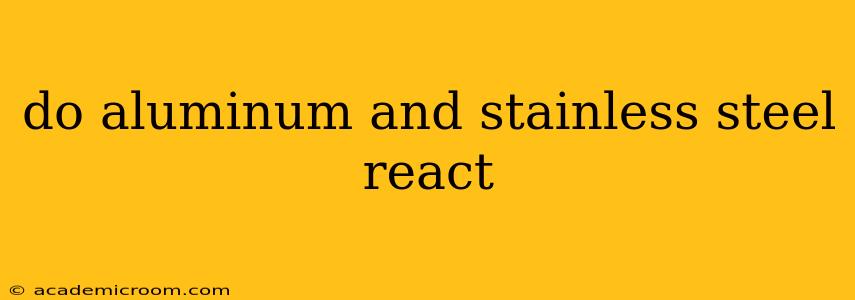Do Aluminum and Stainless Steel React? Understanding Galvanic Corrosion
Aluminum and stainless steel are both popular metals used in a wide range of applications, from construction and automotive to cookware and appliances. However, when these two metals come into contact in the presence of an electrolyte (like water or saltwater), a phenomenon called galvanic corrosion can occur. This article will explore whether aluminum and stainless steel react, the conditions under which this reaction happens, and what measures can be taken to prevent it.
What is Galvanic Corrosion?
Galvanic corrosion, also known as dissimilar metal corrosion, happens when two different metals are in electrical contact with each other in the presence of an electrolyte. One metal becomes the anode (sacrificial metal), corroding and losing electrons, while the other becomes the cathode, gaining electrons and remaining relatively protected. The rate of corrosion depends on the difference in electrochemical potential between the two metals – the larger the difference, the faster the corrosion.
Do Aluminum and Stainless Steel React? Yes, under certain conditions.
Aluminum is more reactive than most stainless steels. This means that in a galvanic couple, aluminum will act as the anode and corrode, while the stainless steel acts as the cathode and is protected. This reaction is more pronounced in environments with high humidity, salt, or acidic conditions. The presence of moisture is crucial, as it acts as the electrolyte, completing the electrical circuit that drives the corrosion process.
How Severe is the Reaction?
The severity of the reaction depends on several factors:
- Type of Stainless Steel: Different grades of stainless steel have varying resistance to corrosion. Austenitic stainless steels (like 304 and 316) are generally more resistant than ferritic or martensitic grades.
- Surface Area: The relative surface areas of the aluminum and stainless steel in contact influence the rate of corrosion. A larger area of aluminum relative to stainless steel will lead to faster corrosion of the aluminum.
- Electrolyte Conductivity: The conductivity of the electrolyte (water, saltwater, etc.) directly impacts the rate of electron flow and thus the corrosion rate. Highly conductive electrolytes accelerate the process.
- Temperature: Higher temperatures generally increase the rate of chemical reactions, including galvanic corrosion.
What are the signs of a reaction?
Signs that aluminum is reacting with stainless steel include:
- Pitting or etching: The aluminum will show signs of localized corrosion, with pits or etched areas appearing on its surface.
- Discoloration: The aluminum may darken or change color near the contact point with the stainless steel.
- White powdery residue: Aluminum oxide, a product of corrosion, may be visible as a white powdery residue.
Can I prevent this reaction?
Fortunately, several measures can minimize or prevent galvanic corrosion between aluminum and stainless steel:
- Isolation: The most effective way to prevent galvanic corrosion is to physically isolate the two metals. This can be done using non-conductive materials like plastic, rubber, or paint between the contact points.
- Protective Coatings: Applying a suitable coating to either metal can provide an effective barrier against the electrolyte, preventing the electrical connection required for corrosion.
- Cathodic Protection: This involves connecting a more active metal (a sacrificial anode) to the aluminum, diverting the corrosive action away from the aluminum and onto the sacrificial metal.
- Selecting Compatible Metals: If possible, choosing materials with similar electrochemical potentials can mitigate galvanic corrosion risks.
Frequently Asked Questions
Q: Does contact between aluminum and stainless steel always lead to corrosion?
A: No, contact alone is not sufficient. An electrolyte (moisture) and an electrical connection are also necessary for galvanic corrosion to occur. In dry conditions, there's little to no reaction.
Q: Is it safe to use aluminum and stainless steel cookware together?
A: While galvanic corrosion can occur, it's typically not a significant concern in cookware unless there's prolonged contact in a highly conductive environment (e.g., leaving aluminum and stainless steel utensils submerged in a salty solution). Proper cleaning and drying minimize any potential issues.
Q: What happens if I use aluminum and stainless steel fasteners together?
A: In outdoor or high-humidity environments, using aluminum and stainless steel fasteners together might lead to aluminum corrosion. Consider using matching metal types or employing isolation techniques in such applications.
Q: Can I repair the corrosion once it has started?
A: Repairing corrosion can be challenging. Depending on the severity, you might be able to clean the affected area and apply a protective coating. In severe cases, replacement may be necessary.
By understanding the conditions that lead to galvanic corrosion between aluminum and stainless steel and employing preventative measures, you can effectively mitigate this potential problem in various applications. Remember to always consult with a material specialist for complex projects or critical applications.
